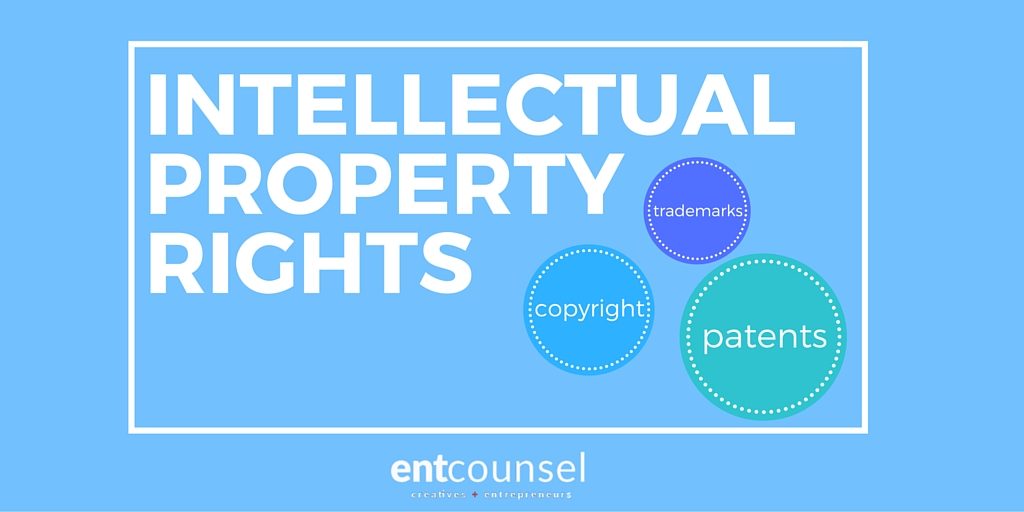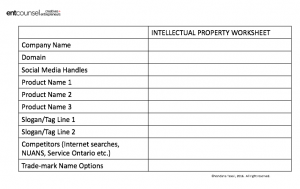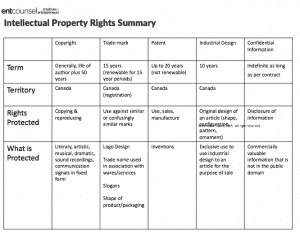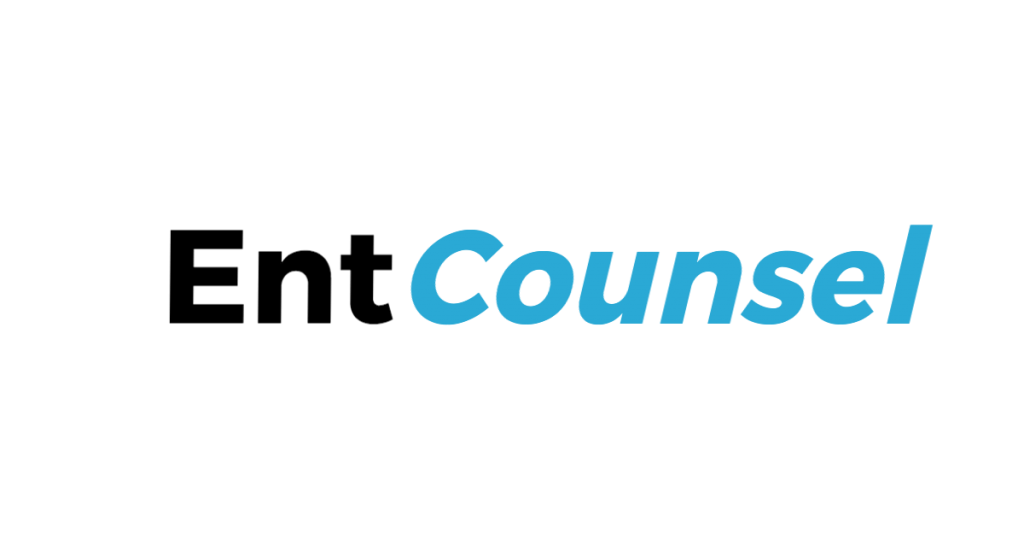[slideshare id=52336147&doc=iprightspresentationsep22015-150902120541-lva1-app6891]
What Are Intellectual Property Rights (subject matters of a licence agt)
- IP is original creative works reduced to a tangible form that can be legally protected. IP includes copyrights, patents, trademarks, industrial design (intangible rights) and trade secrets & confidential information. It’s intangible and invisible so easier for others to use unless physical property.
- Rights of exploitation (selling, assigning or licensing)
- Literary, artistic, or scientific works
- There are two classes of intellectual property rights:
- “Hard” intellectual property rights (patents, trademarks, copyright which are protected by legislation)
- “Soft” intellectual property rights (confidential information, trade secrets and know how which are not protected by legislation but are still intangible rights)
- When IP licenced = royalty or licence fee agreement that outlines the rights & obligations of each party
Patent
- Gives the owner the exclusive right to manufacture, use and sell the invention (and prevent others from doing so)
- Patents provide the most exclusivity & protection for 20 years from the filing of the application
- Patents must meet four requirements:
- Patentable subject matter (any new and useful art, process, machine, manufacture or composition of matter or improvement)
- Novelty (must not be disclosed prior to filing date of application (if by third party) or prior to one year before the filing date of the application (if disclosure by inventor).
- Non-obviousness (inventive ingenuity)
- Utility (functional purpose)
Trademarks
- Gives the owner the exclusive right to the use of the trademark in Canada in respect of the wares/services associated with it and prevent others from using the same or confusingly similar marks
- Words, designs, symbols, colours, fragrances or “get-up” of package of product
Copyrights
- Gives the owner the sole right to produce or reproduce the protected work.
- Copyright can subsist in original literary, artistic, musical or dramatic works
- Copyright includes the following rights (which may be licensed individually or bundled):
- Perform the work in public
- Public the work, if unpublished
- Produce, reproduce, perform or publish any translation of the work
- Convert a dramatic work into a novel or other non-dramatic work;
- Convert any non-dramatic work into a dramatic work by way of performance in public or otherwise;
- Make a sound recording, cinematograph film or other contrivance by means of which a literary, dramatic or musical work can be mechanically reproduced or performed;
Why Are IP Rights Important?
- Competitive Advantage important for founders to offer something unique
- Exclusive Use Copyright, trademark and patent registrations protects you from others using your names, creations and inventions
- Additional Source of Revenue through Licensing
- Protection Against Infringement
- Note: If your business process if not protected by IP, you can still gain a competitive advantage by protecting your trade secrets and confidential information
Intellectual Property Work Sheet
1)Products & Services – List all your companies products and services (eg. Software, computer code, documentation, packaging, customer lists, supplier lists etc)
2)Categories – Group into categories and identify whether it can be protected as a patent, trade-mark, confidential information or copyright
3)Select Your Domain – When choosing a company name, brand name or trade name, choose the domain name at the same time (.com, .org and .ca are the best)
4)Choose Company Name do searches to check availability (Service Ontario, NUANS, Social Media handles and Google Searches)
5)Slogans – Write down any brand names or slogans associated with your company name
6)Unique – Make sure your trade-mark is unique and different from any other trade-mark or brand
What is Copyright?
- Statutory Right
- “Every original literary, dramatic, musical and artistic work includes every original production in the literary, scientific or artistic domain, whatever may be the mode of expression”.
- Right to produce, reproduce, perform, adapt, translate, publish, make a recording, communicate by telecommunication, exhibit an artistic work, rights to communicate a work by telecommunication to the public and the right to rent out certain works.
What Can You Copyright?
- Copyright is automatic upon creation and fixed in a tangible form
You can copyright:
- Literary
- Dramatic
- Musical
- Sound Recordings
- Communication signals in a fixed form
- Etc.
You cannot copyright:
- Ideas (copyright does not subsist in ideas but the expression of those ideas in a fixed form)
- Public domain works
- Factual information
- Brand names, slogans, titles, etc.
- Copyright notice not mandatory but provides protection in other countries
- © [Year of First Publication]. [Copyright Owner]. All Rights Reserved.
Advantage of a Copyright Registration
- Copyright is automatic. Registration is not mandatory.
- Advantage äóñ presumption of copyright ownership to registrant
- Onus of disproving this is on the defendant
- If a defendant can prove that he/she was not aware that copyright subsisted in the work, then plaintiff is only entitled to an injunction (not damages).
Copyright Infringement
- It is an infringement if a person copies the whole or substantial part of a work
- Copyright is infringed if you sell, lease, distribute, exhibit by way of trade, import for sale or hire copyright protected work(s) into Canada
Remedies for Copyright Infringement
- Injunction
- Order for the detention of imported infringing copies
- Damages
- Accounting of profits
- Recovery of infringing copies
- Costs
Moral Rights
- Two Rights :
- 1) The right to receive credit and be associated with your work
- 2) the right not to have your work changed or modified
- Moral rights may only be waived and not sold or licensed
Citizenship Requirements
- Author must be a citizen or ordinarily resident in Canada or
- A citizen in a country to which the Copyright Act applies or
- A published work must first be published in Canada or a country to which the Copyright Act applies
What Is a Trade-mark?
- Word or words
- Phrase
- Design
- Picture
- Symbol
- Number(s)
- Shape of a product (distinguishing guise)
- Packaging or label
- Colour
- (or any combination of the above)
- A trade-mark is used to distinguish the wares/services from a competitor
Word Mark vs. Design Mark
- A word mark consists of just the words
- A design mark consists of the logo and graphics (with or without text)
- Examples: company name, logo, slogan, brand names of products/services, shape or product or packaging
Use
- You must use the trade-mark in order for you to rely on trade-mark rights
- You can put the trade-mark on packaging at the time of the sale
- For a service, you can use the trade-mark in the advertising of the services or when providing the services
- You can file a trade-mark application based on use or proposed use
Advantages of Trade-mark Registration
- Exclusive right to use the mark across Canada for 15 years (renewable every 15 years)
- Process can be time consuming
- Eg. IndieGoGo filed a trade-mark application October 23, 2013
- They have been using it since January 14, 2008
- They obtained the trade-mark registration on January 15, 2015
Common Law rights for Trade-marks (Protection if you don’t register)
- Registration is not mandatory and trade-mark rights can be established under common law (case law)
- However, protection under common law is limited to the geographical area where the brand is being used
Trade-marks that Cannot be Registered
- Names and surnames
- Clearly descriptive marks (unique is better)
- “deceptively misdescriptive” marks
- Words that denote a geographical location commonly known to be the place of origin of such goods or wares
- Words in other languages
- Words or designs that are considered confusing with a previously registered trade-mark or pending trade-mark
Remedies for Trade-mark Infringement
- Injunction
- Damages or accounting of profits
- Destruction of infringing materials
- Possible criminal prosecution
- Costs
SHOPIFY
- Trade name (company name) : SHOPIFY
- Trade-mark: Shopify
- Domain name: www.shopify.ca
OCAD UNIVERSITY
- Trade names: OCAD, OCAD U, OCAD UNIVERSITäó»y,
- Trade-marks: OCAD UNIVERSITY, OCADU, OCAD, ONTARIO COLEGE OF ART & DESIGN
- Domain Name: www.ocadu.ca
- No trade-mark application for “Imagination Catalyst”
KLEENEX
- Trade name (company name): Kimberly-Clark Worldwide, Inc.
- Trade-marks: Kleenex, Soft Touch, Beyond Forests, Someone Needs One (Proposed Use)
- Domain name: www.kleenex.com
What is Industrial Design?
- An original design of article (features of shape, configuration, pattern or ornament and any combination)
- Must be appealed to by the eye
- There must be some form of ornamentation
What is the Process for Registration?
- Registration must be applied for within one year from the date of first publication in Canada
- Offering or making the design available to the public constitutes publication
Advantages of Registration
- Exclusive use to use the industrial design to an article for the purpose of sale
- Registration is valid for 10 years from the date of registration
Remedies for Infringement
- Damages
- Injunction
- Recovery of infringing material
- Accounting of profits
- Fines for criminal offences under the Industrial Design Act
- If infringer not aware of the registration, then remedy limited to injunction (and no damages)
What Are Patents
- “Any new and useful art, process, machine manufacture or composition of matter or any new and useful improvement in any art, process, machine, manufacture or composition of matter”
- What Is Patentable?
- Must be new or novel wasn’t known or reported before
- Useful or have some utility has to have practical application
- Non-obvious not obvious from prior inventions or information already available
- Patent Application Process
- Remedies for Patent Infringement





